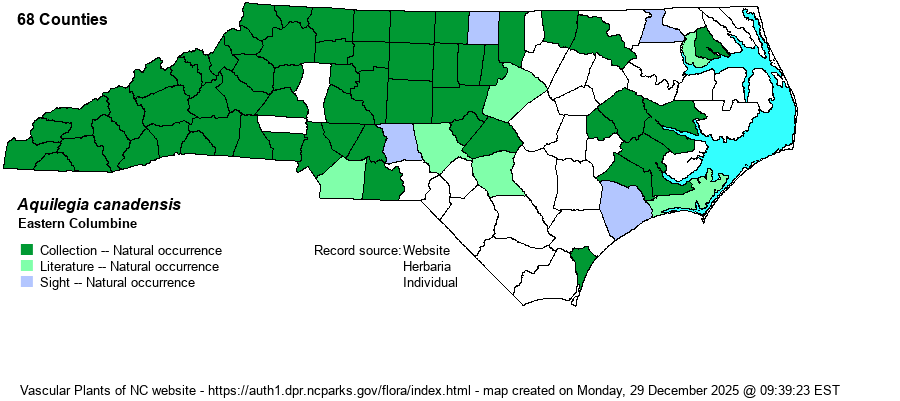| Author | L. | |
| Distribution | Throughout the Mountains and most of the Piedmont. Scattered over parts of the Coastal Plain, mainly the east-central portions and isolated places northward. Nearly absent from the Sandhills proper and southern Coastal Plain.
This is a very widespread Eastern and Central North American species, ranging south to SC, the FL Panhandle, and central TX. | |
| Abundance | Frequent to locally common in the Mountains and foothills; generally uncommon to locally fairly common in the Piedmont, though relatively rare in the extreme eastern portions near the Fall Line. Rare in most of the Coastal Plain, and locally uncommon in part of the eastern Coastal Plain in some marl-dominated habitats. | |
| Habitat | This species has a great array of habitats, and all or nearly all occur over high pH soil, over calcareous (marl or limestone) or mafic (amphibolite, gabbro, etc.) rocks. It can occur in rich forests, usually near or at outcrops; along stream banks, usually near rocks; on dry or moist cliffs or bluffs; on shell deposits and marl banks, and other dry forested places. It prefers shaded or semi-shaded habitats, but it can be found in some man-altered habitats, as long as the soils are high pH and usually at or near rocks. |
| Phenology | Blooms from March to May; fruits shortly after blooming. | |
| Identification | This is a very familiar species, though many people are likely more familiar with it, if not only familiar with it, in gardens or other plantings. It is a rather tall herbaceous species, to about 2-2.5 feet tall. It has both basal and cauline (stem) leaves, rather similar to each other. The several basal leaves are trifoliate, with the 3 leaflets each with several lobes, looking like a small glove -- rounded but without obvious serrations. Midway up the stem are the leaves, often just one at a node, and becoming smaller and often just unlobed farther up the stem. The upper portions have a few branches, and on the branch tips are the unique (for the East) and very showy flowers. Each flower is red (the sepals), and yellow on the interior (petals), with 1-inch-long spurs off the back of the flower, away from the male and female parts. Thus, each of the handful of flowers on an individual plant is roughly 1.5 inches long, and most point downward -- completely striking at any distance. On some occasions, you might simply find plants with basal leaves only, or just those leaves and a short stem just elongating. These can usually be identified by the 3 glove-like leaflets and generally by a soft blue-green color to them. | |
| Taxonomic Comments | None
| |
| Other Common Name(s) | Red Columbine, Eastern Red Columbine, Canada Columbine, Wild Columbine | |
| State Rank | S4 [S5] | |
| Global Rank | G5 | |
| State Status | | |
| US Status | | |
| USACE-agcp | FACU link |
| USACE-emp | FAC link |

